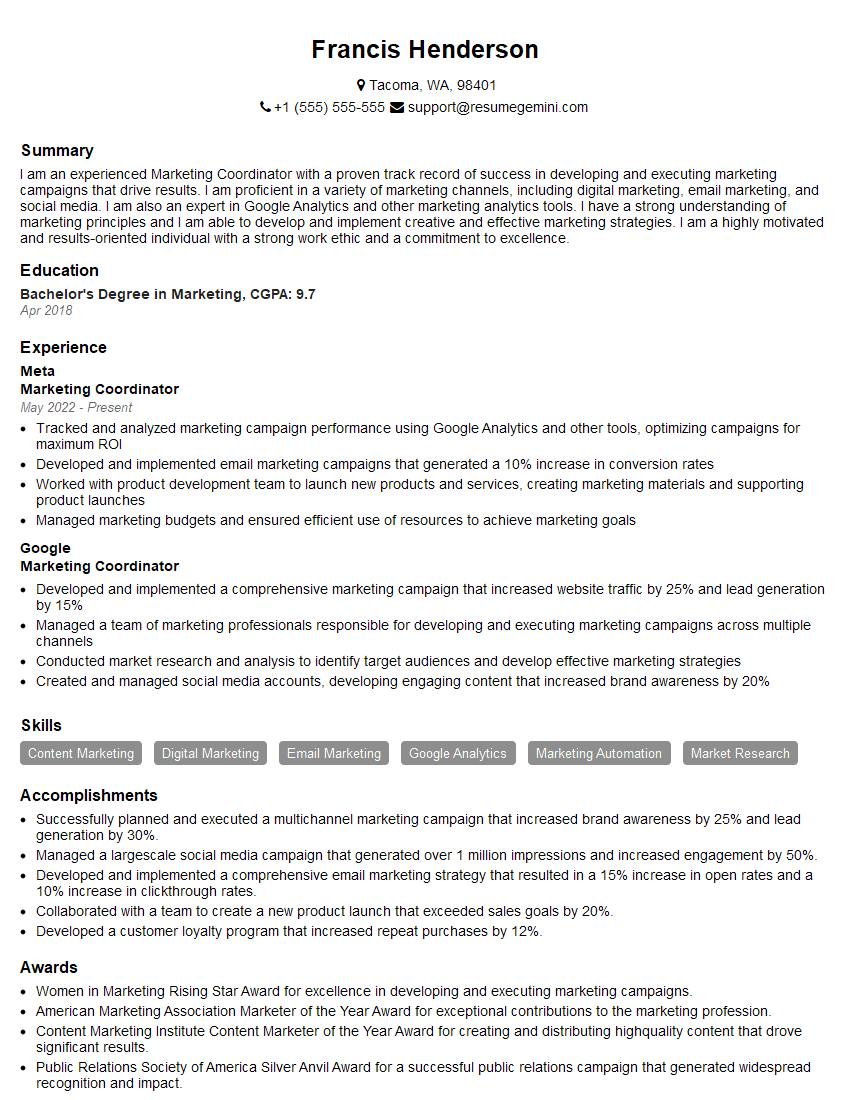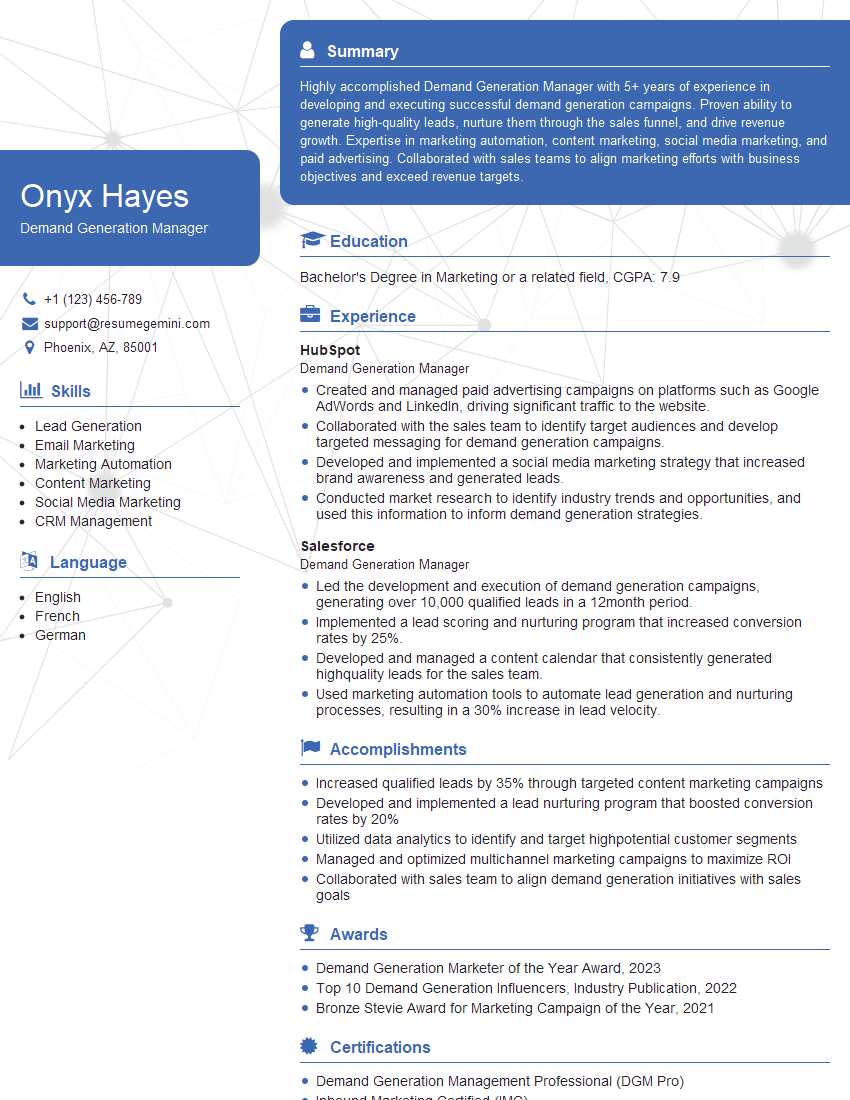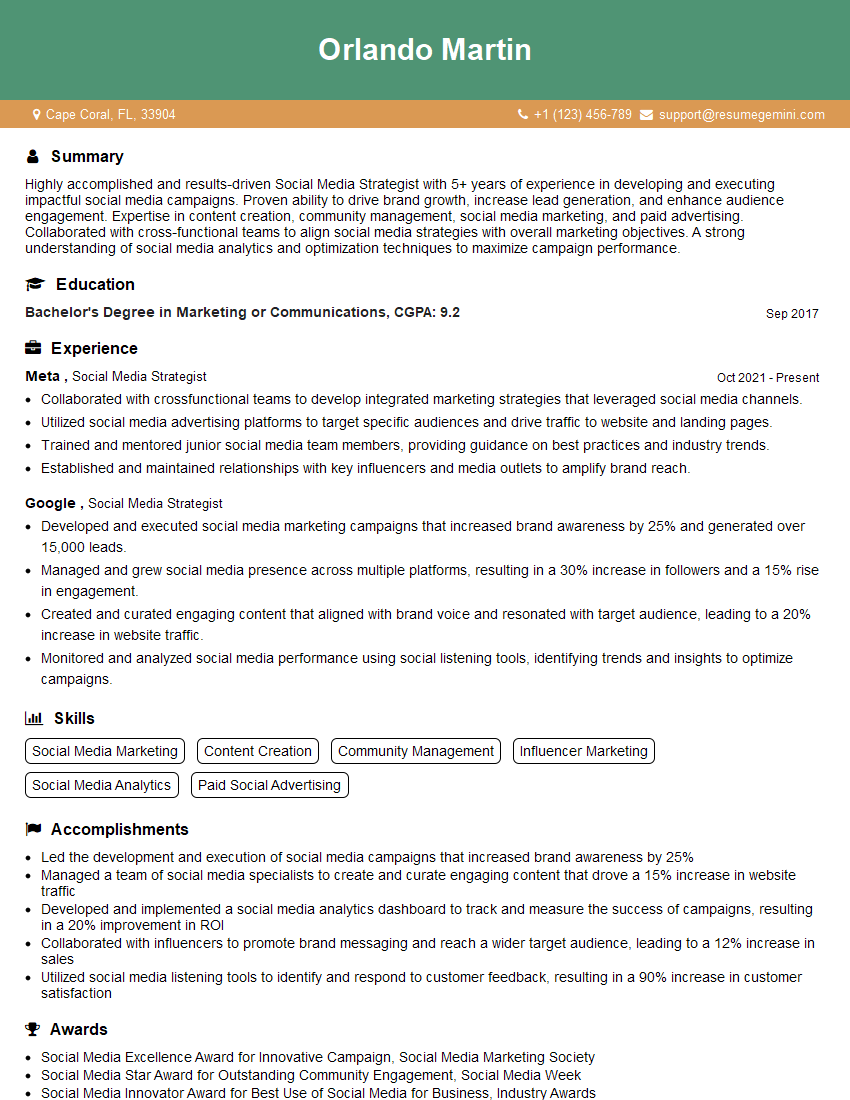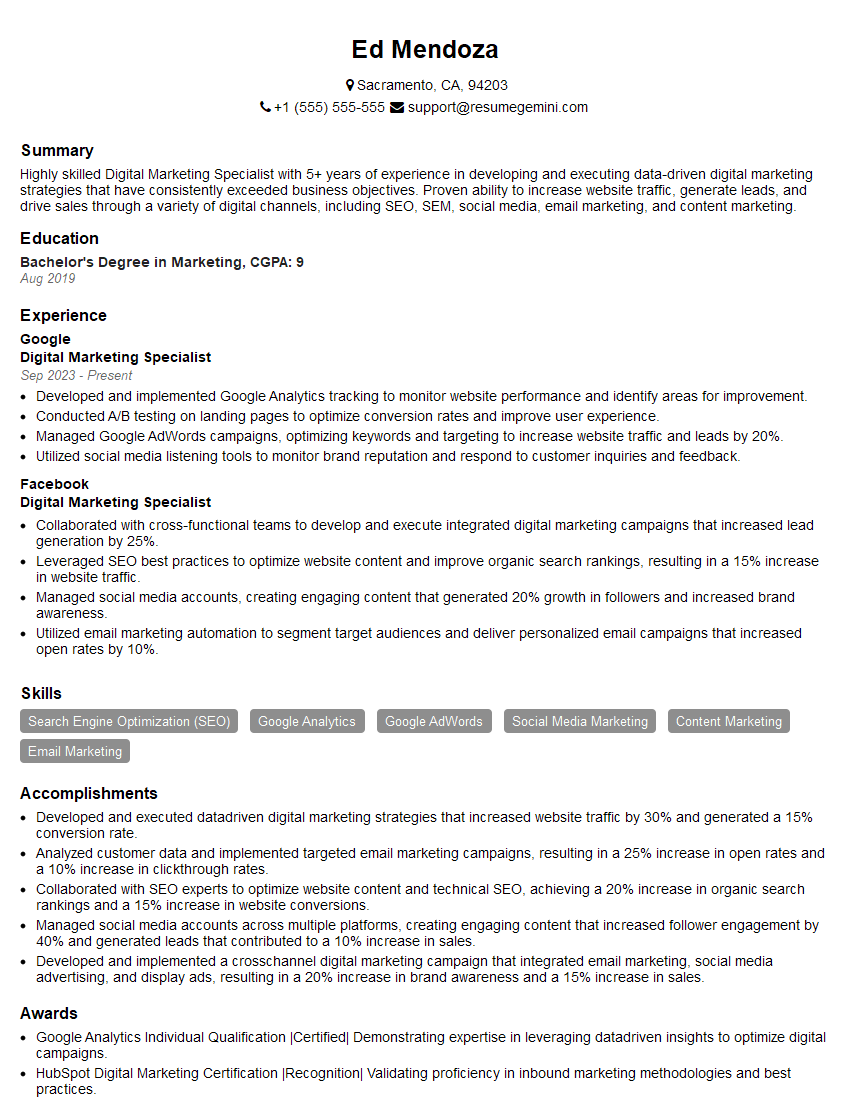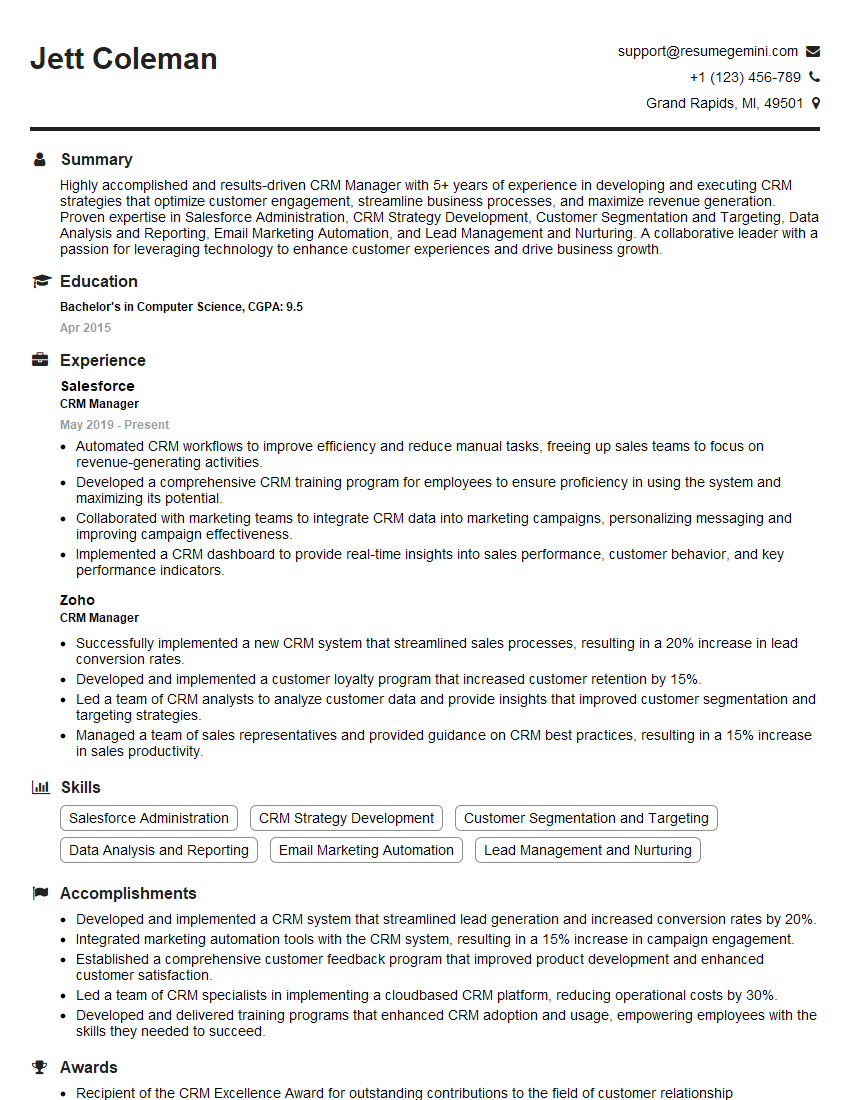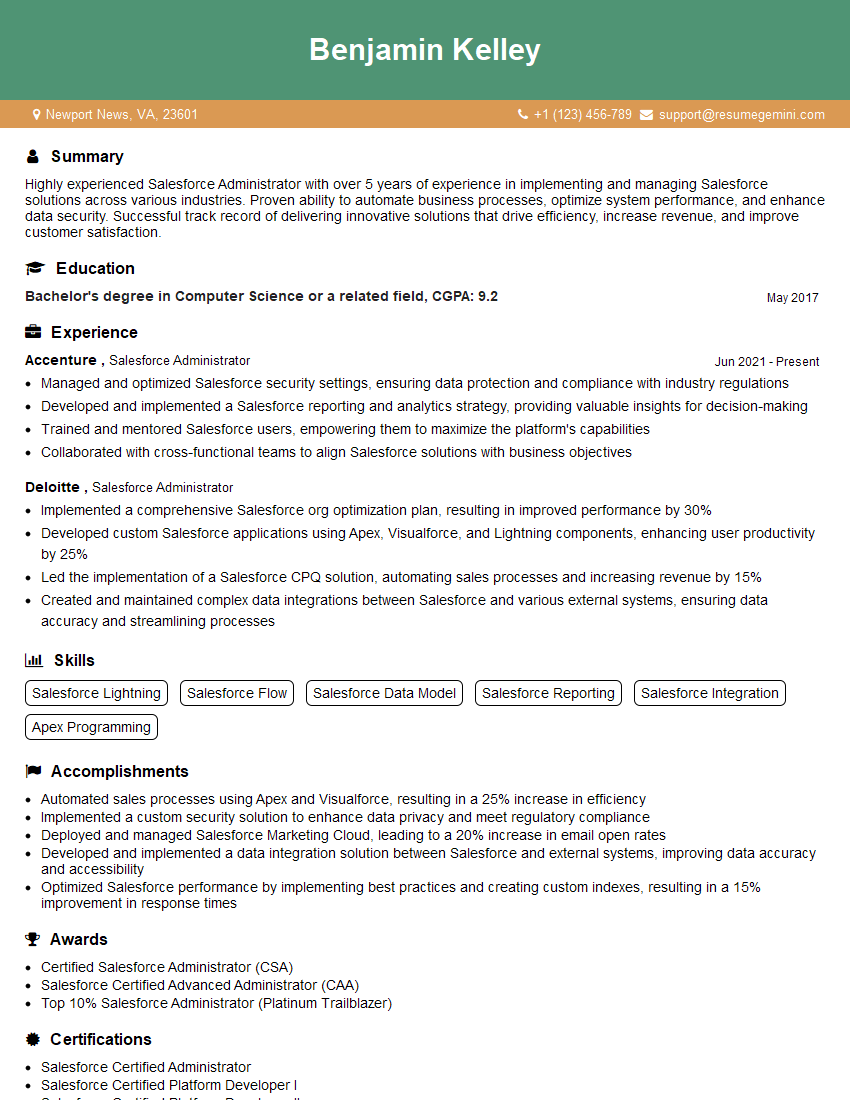Feeling uncertain about what to expect in your upcoming interview? We’ve got you covered! This blog highlights the most important CRM and Influencer Management Tools interview questions and provides actionable advice to help you stand out as the ideal candidate. Let’s pave the way for your success.
Questions Asked in CRM and Influencer Management Tools Interview
Q 1. What CRM systems are you familiar with?
I’m proficient in several CRM systems, each with its strengths and weaknesses. My experience includes working extensively with Salesforce, HubSpot, and Zoho CRM. Salesforce, for example, is a robust platform ideal for large enterprises with complex sales processes and extensive data needs. Its customization options are unparalleled, allowing for tailored workflows to suit specific business requirements. HubSpot, on the other hand, excels in its integrated marketing and sales functionalities, making it a strong choice for businesses focusing on inbound marketing strategies. Finally, Zoho CRM offers a more cost-effective solution, particularly suitable for smaller businesses or startups needing a simpler, yet powerful, system. My experience spans across implementing, customizing, and managing these platforms, ensuring data integrity, efficient workflow optimization, and insightful reporting.
Q 2. Describe your experience with influencer marketing platforms.
My experience with influencer marketing platforms is extensive, encompassing both large-scale enterprise solutions and more niche platforms. I’ve worked with Upfluence, Grin, and Traackr, each offering unique capabilities. Upfluence, for instance, is a great tool for discovering and managing micro-influencers, focusing on campaign performance tracking and detailed analytics. Grin shines with its focus on simplifying the workflow and managing collaborations, while Traackr is better suited for enterprise-level influencer programs that demand sophisticated reporting and data analysis. I understand the nuances of each platform – from campaign creation and influencer onboarding to performance monitoring and reporting – and can tailor my approach to best leverage the strengths of each platform depending on the specific campaign goals and budget.
Q 3. How do you measure the ROI of influencer marketing campaigns?
Measuring ROI in influencer marketing requires a multi-faceted approach. It’s not just about likes and shares. We need to connect influencer actions to concrete business outcomes. I typically track key metrics such as:
- Website traffic: Using UTM parameters in influencer campaign links, we track website visits, conversions, and engagement.
- Sales conversions: We monitor sales generated directly attributable to influencer campaigns, often using unique discount codes or promotional links.
- Brand awareness and reach: We measure the increase in brand mentions, social media engagement, and overall reach driven by the campaign.
- Lead generation: We track leads generated through landing pages or forms linked to influencer content.
- Customer acquisition cost (CAC): Comparing the cost of the influencer campaign to the number of customers acquired helps determine the campaign’s efficiency.
By analyzing these metrics, we can build a comprehensive picture of the campaign’s impact and calculate a clear ROI. For example, if an influencer campaign cost $5,000 and generated $20,000 in sales, the ROI is 300%.
Q 4. Explain your process for identifying and selecting influencers.
My process for identifying and selecting influencers begins with a thorough understanding of the target audience and campaign objectives. This involves:
- Defining target audience demographics and psychographics: Understanding their interests, online behavior, and preferred platforms is crucial.
- Identifying relevant influencers: Using influencer marketing platforms and social listening tools, we search for influencers aligning with the brand’s values and target audience.
- Analyzing influencer performance metrics: This includes engagement rates, audience demographics, audience authenticity, and previous campaign performance.
- Reviewing influencer content: Ensuring the influencer’s style and content align with the brand’s voice and messaging is paramount.
- Vetting influencers: We assess their authenticity, credibility, and engagement to avoid fraudulent or low-quality influencers.
- Negotiating and contracting: Finally, we establish clear contracts outlining deliverables, timelines, and payment terms.
This multi-step approach ensures we select influencers who are not only relevant but also effective in achieving campaign goals.
Q 5. How do you manage influencer relationships?
Managing influencer relationships is key to long-term success. I believe in building genuine partnerships based on mutual respect and clear communication. My approach involves:
- Establishing clear communication channels: Regular communication through email, project management tools, or even direct calls is crucial.
- Providing timely feedback and support: Offering constructive feedback and addressing any concerns promptly fosters positive relationships.
- Offering creative freedom while maintaining brand guidelines: Empowering influencers allows for more authentic content, but maintaining brand consistency is also important.
- Building long-term relationships: Nurturing relationships extends beyond individual campaigns. This includes thanking influencers, sharing campaign results, and exploring potential future collaborations.
- Tracking influencer performance and providing reports: Transparency in campaign performance is important to maintain trust and show the value of the partnership.
By prioritizing open communication and mutual respect, we build strong, lasting relationships with influencers.
Q 6. What metrics do you use to track CRM performance?
Tracking CRM performance hinges on defining clear Key Performance Indicators (KPIs) aligned with business objectives. I typically monitor:
- Sales conversion rates: Measuring the percentage of leads converting into paying customers.
- Customer acquisition cost (CAC): The cost of acquiring a new customer.
- Customer lifetime value (CLTV): The predicted revenue generated by a customer over their relationship with the company.
- Lead generation rates: Measuring the number of leads generated through different marketing channels.
- Customer retention rate: The percentage of customers retained over a specific period.
- Average revenue per user (ARPU): The average revenue generated per customer.
- Customer satisfaction (CSAT): Measuring customer happiness through surveys and feedback.
These metrics help assess the efficiency and effectiveness of the CRM system in supporting sales and marketing efforts. Regular reporting and analysis of these KPIs allow for data-driven decision-making and continuous improvement.
Q 7. How do you segment your customer data in a CRM?
Customer segmentation is vital for targeted marketing and personalized experiences. In a CRM, I utilize various methods to segment data. This involves using both:
- Demographic segmentation: Grouping customers based on age, location, gender, income, etc. For example, segmenting customers based on age allows us to tailor marketing messages to resonate with different generations.
- Behavioral segmentation: Grouping customers based on their past interactions with the brand, such as purchase history, website activity, email engagement, etc. For example, segmenting customers based on their purchase frequency allows us to create targeted loyalty programs.
- Psychographic segmentation: Grouping customers based on their values, lifestyles, interests, and attitudes. For example, segmenting customers based on their interests allows us to send targeted promotions for products aligned with their passions.
- Firmographic Segmentation (B2B): Grouping business customers based on company size, industry, revenue, etc.
By combining these methods, we create highly targeted customer segments, enabling us to personalize communication and offer relevant products and services. This leads to improved customer engagement, higher conversion rates, and increased customer lifetime value.
Q 8. Describe your experience with CRM data migration.
CRM data migration is the process of moving data from one CRM system to another or to a completely different database. It’s a critical task, often complex, requiring meticulous planning and execution to avoid data loss or corruption. My experience encompasses migrations of varying scales, from small business transitions to large enterprise-level projects involving millions of records.
I’ve managed migrations using various methods, including direct database exports/imports, ETL (Extract, Transform, Load) tools like Informatica PowerCenter or Talend Open Studio, and cloud-based migration services. The key is to define a clear scope, map the data fields accurately between systems, and rigorously test the migrated data for completeness and accuracy. For instance, in one project, we migrated data from a legacy system to Salesforce Sales Cloud. We used an ETL tool to cleanse, transform, and load the data, ensuring data integrity throughout the process. We also implemented a robust validation process post-migration to verify data accuracy and completeness.
A successful migration hinges on thorough planning. This involves identifying data sources, defining target schemas, cleansing the source data, performing data mapping, testing the migration process thoroughly, and ensuring data security and compliance. It’s crucial to understand your existing data structure and the desired structure in the new system to prevent data inconsistencies.
Q 9. How do you handle CRM data cleansing and deduplication?
CRM data cleansing and deduplication are essential for maintaining data quality and ensuring the reliability of marketing and sales efforts. Cleansing involves identifying and correcting inaccurate, incomplete, or irrelevant data. Deduplication removes duplicate records, preventing misleading analytics and inefficient marketing campaigns.
My approach begins with identifying data quality issues. This often involves analyzing data for inconsistencies, incomplete fields, and duplicate entries. Then, I employ a combination of techniques, including:
- Automated tools: Using CRM-specific or third-party data cleansing tools to identify and correct inconsistencies automatically. These tools can often handle tasks like standardizing addresses and formatting phone numbers.
- Manual review: Spot-checking results and manually resolving complex issues that automated tools may miss. For example, I may need to manually decide which of two seemingly duplicate contacts is the correct one.
- Data matching algorithms: Using advanced techniques to identify near-duplicate records based on similarity in names, email addresses, or other fields. This is crucial for capturing records that aren’t exact duplicates but still represent the same person or company.
- Data validation rules: Implementing data validation rules within the CRM system to prevent the entry of incorrect data in the future.
For instance, in a recent project, we used a combination of an automated deduplication tool and a manual review process to cleanse and deduplicate a client’s contact list, resulting in a 15% reduction in duplicate entries and improved data accuracy.
Q 10. What are some common CRM reporting challenges and how do you address them?
Common CRM reporting challenges often stem from poor data quality, inadequate reporting tools, or a lack of clear reporting objectives. I’ve encountered issues like inaccurate data leading to misleading conclusions, cumbersome report generation processes, and difficulty in accessing real-time data.
To address these challenges, I use a multi-pronged approach:
- Data quality improvement: Addressing the root cause of inaccurate data through cleansing and deduplication, as discussed earlier.
- Choosing the right reporting tools: Selecting tools that offer the functionalities needed, such as custom report building, data visualization, and real-time dashboards. The CRM’s native reporting tools are often a good starting point but may require integration with BI tools for more advanced analysis.
- Defining clear reporting objectives: Understanding the business questions that need to be answered with the reports. This ensures that the reports provide relevant and actionable insights.
- Data visualization: Presenting data clearly and concisely through charts, graphs, and dashboards to facilitate easy interpretation and identification of trends.
- Training and support: Ensuring that stakeholders are properly trained on how to use and interpret the reports effectively.
For example, when faced with a client struggling to generate meaningful sales reports from their CRM, I helped them improve data quality, select appropriate reporting tools, and define key performance indicators (KPIs) to track their sales performance more accurately and effectively.
Q 11. How do you integrate CRM data with other marketing tools?
Integrating CRM data with other marketing tools is crucial for creating a unified view of customer interactions and maximizing marketing efficiency. This integration allows for seamless data flow between different platforms, automating tasks and improving overall marketing performance.
Integration methods vary depending on the tools involved. Common approaches include:
- API integrations: Utilizing Application Programming Interfaces to directly connect the CRM with other platforms like marketing automation tools (e.g., Marketo, HubSpot), email marketing platforms (e.g., Mailchimp), and analytics platforms (e.g., Google Analytics). This allows for real-time data synchronization and automated workflows.
- Data imports/exports: Manually or automatically importing and exporting data between systems, often using CSV or other file formats. This is less efficient than API integrations but can be suitable for less frequent data transfers.
- Third-party integration platforms: Using tools like Zapier or Integromat to connect various applications and automate data transfer. These tools offer pre-built integrations for many popular platforms, simplifying the integration process.
For example, I integrated a client’s Salesforce CRM with their Marketo marketing automation platform using APIs. This allowed for automated lead nurturing campaigns, personalized email marketing, and real-time tracking of campaign performance. This integration significantly improved their marketing efficiency and lead conversion rates.
Q 12. Explain your experience with marketing automation workflows.
Marketing automation workflows streamline repetitive tasks, personalize customer interactions, and optimize marketing campaigns. My experience encompasses designing, implementing, and optimizing various workflows using different marketing automation platforms.
I typically follow a structured approach to building workflows:
- Defining goals and objectives: Clearly defining the desired outcomes of the workflow, such as increased lead generation, improved customer engagement, or higher conversion rates.
- Identifying key customer segments: Segmenting the customer base based on relevant criteria to personalize the workflow.
- Designing the workflow: Mapping out the sequence of actions, including email sends, lead scoring, task assignments, and other automated actions.
- Implementing and testing: Putting the workflow into action and rigorously testing to ensure it functions as intended.
- Monitoring and optimizing: Tracking the performance of the workflow and making adjustments as needed to improve its effectiveness. A/B testing is a critical component of this stage.
For example, I once designed a lead nurturing workflow for a client using HubSpot. The workflow segmented leads based on their level of engagement and delivered a series of personalized emails and targeted content, leading to a 20% increase in qualified leads.
Q 13. Describe a time you had to troubleshoot a CRM issue.
In one instance, a client experienced a significant slowdown in their CRM system after a data migration. The initial investigation pointed towards database performance issues, but the problem was more nuanced.
My troubleshooting steps were as follows:
- System Monitoring: I started by monitoring the system’s resource utilization (CPU, memory, disk I/O) to identify bottlenecks.
- Log Analysis: I analyzed the CRM’s logs to pinpoint the cause of the slowdown. This revealed frequent queries targeting a specific, poorly optimized table.
- Database Optimization: I worked with the database administrator to optimize the problematic table by adding indexes and improving query performance.
- Code Review (where applicable): In this case, the issue wasn’t in the code, but in some scenarios this would be the next step.
- Testing and Validation: After implementing the changes, I thoroughly tested the system to ensure the issue was resolved and performance had improved.
This systematic approach allowed us to quickly identify and resolve the issue, restoring the CRM system to its optimal performance. The key takeaway was the importance of thorough log analysis and collaboration with other technical teams.
Q 14. How do you ensure data accuracy in your CRM?
Ensuring data accuracy in a CRM is an ongoing process, not a one-time task. It requires a combination of preventive measures and proactive monitoring.
My approach involves:
- Data Validation Rules: Implementing data validation rules within the CRM to prevent the entry of inaccurate or incomplete data. This includes things like mandatory fields, data type restrictions, and format validations.
- Data Cleansing Processes: Regularly cleansing and deduplicating data to identify and correct inaccuracies, as discussed previously.
- User Training: Providing adequate training to users on proper data entry procedures to ensure consistency and accuracy.
- Data Monitoring and Auditing: Regularly monitoring data quality through reports and dashboards, and conducting periodic audits to identify potential issues.
- Data Governance Policies: Establishing clear data governance policies and procedures to ensure accountability for data accuracy and integrity.
- Integration with other systems: Ensuring consistent data across all integrated systems, to prevent discrepancies arising from data silos.
By proactively addressing potential issues and regularly monitoring data quality, we can ensure that the CRM maintains its accuracy and reliability, leading to more effective marketing and sales operations. A regularly updated data governance policy is essential for this process, acting as a living document to reflect the evolving needs of the organization.
Q 15. What are some best practices for influencer campaign reporting?
Effective influencer campaign reporting goes beyond vanity metrics like likes and comments. It requires a multi-faceted approach focusing on key performance indicators (KPIs) aligned with your overall marketing objectives.
- Define Clear Goals: Before the campaign, establish specific, measurable, achievable, relevant, and time-bound (SMART) goals. Are you aiming for brand awareness, lead generation, or sales? This dictates your KPIs.
- Track Relevant Metrics: Monitor metrics like website traffic (from unique links in influencer posts), conversion rates (e.g., purchases, sign-ups), engagement rate (likes, shares, comments normalized by follower count), reach (total number of unique individuals exposed to the content), and brand mentions (tracking mentions across various platforms). Use UTM parameters to track specific campaign sources.
- Utilize Reporting Tools: Leverage CRM systems with influencer marketing modules or dedicated influencer marketing platforms that provide comprehensive reporting dashboards. These tools often automate data collection and visualization.
- Qualitative Analysis: Don’t solely rely on numbers. Analyze audience sentiment from comments and mentions. Assess the overall tone and message resonance. Did the influencer authentically represent your brand values?
- Compare Across Influencers: Analyze performance across different influencers to understand which strategies and influencer types yield the best results. This helps optimize future campaigns.
- Post-Campaign Report: Prepare a detailed report summarizing campaign performance against pre-defined goals. Include key findings, insights, and recommendations for future campaigns.
Example: For a lead generation campaign, a key metric might be the number of qualified leads generated through a unique landing page URL shared by the influencer. The report would detail the number of clicks, conversions, and cost-per-lead.
Career Expert Tips:
- Ace those interviews! Prepare effectively by reviewing the Top 50 Most Common Interview Questions on ResumeGemini.
- Navigate your job search with confidence! Explore a wide range of Career Tips on ResumeGemini. Learn about common challenges and recommendations to overcome them.
- Craft the perfect resume! Master the Art of Resume Writing with ResumeGemini’s guide. Showcase your unique qualifications and achievements effectively.
- Don’t miss out on holiday savings! Build your dream resume with ResumeGemini’s ATS optimized templates.
Q 16. How do you identify potential conflicts of interest with influencers?
Identifying potential conflicts of interest is crucial for maintaining transparency and ethical influencer marketing. A proactive approach involves a thorough vetting process before collaboration.
- Disclosure Policies: Require influencers to disclose any existing relationships or affiliations that could be perceived as a conflict of interest. This includes sponsorships, brand ambassadorships, or competitive product endorsements.
- Social Media Audit: Review the influencer’s social media presence for past posts and endorsements to identify potential conflicts. Look for any inconsistent messaging or affiliations that could damage your brand image.
- Audience Alignment: Ensure the influencer’s audience aligns with your target market. An incongruence could lead to audience distrust and negative perceptions.
- Contractual Clauses: Include clauses in influencer contracts that address potential conflicts and define procedures for handling them. This ensures transparency and accountability.
- Ongoing Monitoring: Continuously monitor the influencer’s activity during and after the campaign to identify any emerging conflicts.
Example: If an influencer frequently promotes a competitor’s product, it would create a conflict of interest when collaborating on a campaign for your brand. Transparency about this previous relationship should be addressed upfront.
Q 17. How do you manage influencer contracts and agreements?
Effective influencer contract management is essential for protecting both your brand and the influencer. It’s not just about a simple agreement; it’s a robust framework for collaboration.
- Clear Scope of Work: Define specific deliverables, including the number of posts, content type, platform(s), posting schedule, and any creative guidelines.
- Payment Terms: Clearly outline payment amounts, payment schedules, and methods (e.g., upfront payment, milestone payments, performance-based incentives).
- Intellectual Property Rights: Specify who owns the rights to the created content. Typically, brands retain the right to use the content for future marketing efforts.
- Content Approval Process: Establish a clear process for reviewing and approving influencer-generated content before publishing. This ensures brand consistency and message alignment.
- Performance Metrics: Define how the success of the campaign will be measured and how it relates to potential performance-based bonuses.
- Confidentiality Clauses: Protect sensitive brand information shared with the influencer by including confidentiality clauses in the contract.
- Dispute Resolution: Outline a process for resolving any disputes that may arise during the campaign.
- Legal Review: Always have legal counsel review contracts before signing to ensure they adequately protect your brand’s interests.
Example: A contract might specify that the influencer will create three Instagram posts, one TikTok video, and one blog post, each with specific hashtags and brand mentions, with payment released upon successful completion and approval of all content.
Q 18. How do you handle negative feedback or crises related to influencers?
Handling negative feedback or crises related to influencers requires a swift, transparent, and proactive approach to mitigate damage to your brand’s reputation.
- Monitor Social Media: Actively monitor social media for any negative comments or mentions related to the influencer or campaign.
- Address Concerns Promptly: Respond to negative feedback promptly and professionally, acknowledging the concern and offering a resolution.
- Assess the Situation: Determine the severity of the issue and its potential impact on your brand. Is it a minor issue or a major crisis?
- Develop a Crisis Communication Plan: If the issue escalates, activate a pre-defined crisis communication plan that outlines roles, responsibilities, and communication strategies.
- Engage with Influencers: Collaborate with the influencer to address the negative feedback and prevent further damage.
- Transparency is Key: Be transparent with your audience about the situation and the steps being taken to resolve it.
- Learn from Mistakes: After the crisis, analyze the situation to identify areas for improvement in future influencer marketing campaigns.
Example: If an influencer posts inaccurate information about your product, immediately issue a correction and work with the influencer to remove the inaccurate post. Then, communicate with your audience to clarify the facts and restore trust.
Q 19. What strategies do you use to increase engagement with influencer content?
Increasing engagement with influencer content requires a strategic approach combining creative content, audience interaction, and campaign optimization.
- Interactive Content: Encourage audience participation through contests, polls, Q&A sessions, and interactive stories.
- User-Generated Content: Encourage followers to create their own content related to your brand and the influencer’s post, using a branded hashtag.
- Targeted Audience Selection: Choose influencers whose audience genuinely aligns with your target market to maximize relevance and engagement.
- Influencer Collaboration: Collaborate with influencers who have a strong track record of engagement and community building. Look at their engagement rate as a key metric.
- High-Quality Visuals: Ensure that the influencer’s content is visually appealing and professional-looking to capture audience attention.
- Strategic Timing: Schedule influencer posts for optimal reach, considering factors such as audience activity patterns and time zones.
- Incentivize Engagement: Offer incentives like giveaways, discounts, or exclusive access to drive engagement with influencer content.
Example: A campaign might include a contest where users who share a post with a specific hashtag are entered to win a prize, incentivizing both the influencer’s followers and your target audience to engage with the content.
Q 20. How do you measure the effectiveness of different influencer marketing strategies?
Measuring the effectiveness of influencer marketing strategies requires a blend of quantitative and qualitative analysis, focusing on pre-defined KPIs.
- Website Traffic: Track website traffic from unique links within influencer posts using UTM parameters.
- Conversions: Monitor conversion rates (sales, leads, sign-ups) originating from influencer campaigns.
- Engagement Rate: Calculate engagement rate (likes, shares, comments, saves normalized by follower count) to assess audience interaction.
- Reach and Impressions: Measure the total number of unique individuals exposed to the influencer’s content and the total number of times the content was displayed.
- Brand Mentions: Track brand mentions across social media platforms to gauge brand awareness and sentiment.
- Sentiment Analysis: Utilize sentiment analysis tools to gauge the overall tone and sentiment surrounding brand mentions.
- Customer Acquisition Cost (CAC): Calculate the cost of acquiring a customer through influencer marketing to assess ROI.
Example: By comparing the cost of acquiring a customer through influencer marketing to the cost through other channels (like paid advertising), you can assess the relative effectiveness and efficiency of this strategy.
Q 21. What experience do you have with A/B testing in influencer marketing?
A/B testing in influencer marketing allows you to optimize campaign strategies by comparing different approaches to identify what resonates best with your audience. This involves creating two or more variations of an influencer campaign and analyzing which performs better.
- Content Variations: Test different content formats (images, videos, stories), messaging styles (humorous, informative, aspirational), or call-to-actions (CTAs).
- Influencer Selection: Test different influencers with varying follower counts, engagement rates, or audience demographics to determine who yields better results.
- Platform Selection: Compare results across different platforms (Instagram, TikTok, YouTube) to identify the most effective channels.
- Timing and Frequency: Experiment with different posting schedules and frequencies to determine the optimal times for engagement.
- Incentives and Promotions: Test different incentives or promotional offers to determine which motivates the audience most effectively.
- Using UTM Parameters: Use UTM parameters to track the performance of each variation and accurately attribute results to specific campaigns.
- Statistical Significance: It’s vital to ensure you have a large enough sample size to obtain statistically significant results.
Example: You might test two different versions of an Instagram post: one with a humorous approach and another with a more informative style. By tracking engagement metrics, you can determine which resonates better with the target audience. Using UTM parameters ensures accurate tracking.
Q 22. Describe your experience using social listening tools.
Social listening tools are invaluable for understanding the conversations happening around your brand and industry on social media. I have extensive experience using tools like Brandwatch, Talkwalker, and Sprout Social. These platforms allow you to monitor mentions of your brand, keywords related to your products or services, and competitor activity. My approach involves setting up specific keyword searches and filters to track relevant conversations. For example, if we’re launching a new skincare line, I’d track keywords like “anti-aging cream,” “sensitive skin,” and competitor brand names. The data gathered reveals customer sentiment, identifies emerging trends, and helps uncover potential crises. I use this information to inform product development, marketing strategies, and customer service responses. For instance, if negative sentiment surrounds a particular ingredient, we might adjust our marketing message or reformulate the product.
Beyond simply monitoring mentions, I analyze the data to identify key influencers who are discussing our brand or relevant topics. This allows us to engage with them directly and potentially build relationships for future collaborations. In essence, social listening allows for proactive brand management and data-driven decision-making.
Q 23. How do you use CRM data to personalize marketing campaigns?
CRM data is a goldmine for personalized marketing. I leverage customer information such as purchase history, demographics, website activity, and engagement with marketing emails to tailor campaigns that resonate with individual customer needs and preferences. Imagine a customer who frequently purchases running shoes from our website. Using CRM data, we can automatically segment them into a “runner” group and send them personalized emails about new running shoe releases, exclusive discounts on running gear, and relevant blog posts about running techniques. This approach is much more effective than sending generic blasts.
Furthermore, I use CRM data to personalize website experiences through dynamic content. This involves dynamically adjusting website content, such as product recommendations or promotional offers, based on the visitor’s profile. For example, if a customer has previously expressed interest in sustainable products, their website experience might showcase our eco-friendly offerings more prominently. This personalized approach strengthens customer relationships, increases engagement, and boosts conversion rates.
Q 24. What are the ethical considerations in influencer marketing?
Ethical considerations in influencer marketing are paramount. Transparency is key. Influencers must clearly disclose any sponsored content or affiliate relationships to avoid misleading their audience. Authenticity is also crucial; collaborations should feel genuine and reflect the influencer’s actual experiences and beliefs. I always emphasize selecting influencers who align with our brand values and target audience. We avoid partnerships that feel forced or inauthentic. For example, if we’re a sustainable brand, we wouldn’t work with an influencer known for promoting fast fashion.
Another important ethical aspect is protecting consumer data. We ensure that all influencer collaborations comply with privacy regulations like GDPR and CCPA. We always have clear contracts in place that outline data usage and protection measures. Finally, we avoid using manipulative tactics or targeting vulnerable audiences. Our goal is to build trust and transparency in all our influencer relationships.
Q 25. How do you manage budgets for influencer marketing campaigns?
Budgeting for influencer marketing campaigns requires a strategic approach. First, we define clear campaign objectives, such as brand awareness, lead generation, or website traffic. Then, we identify the key performance indicators (KPIs) that will measure success, such as engagement rate, reach, and conversions. This allows us to determine a realistic budget based on the scope and objectives of the campaign. We allocate funds across different activities, such as influencer selection, content creation, campaign management, and reporting.
I typically use a tiered approach, allocating a larger portion of the budget to influencers with a higher reach and engagement rate. However, micro-influencers can also be highly effective and often come with a lower cost. The budget is also influenced by the type of content created. High-quality video content, for example, will be more expensive to produce than a simple Instagram post. Regular monitoring and adjustments are crucial to ensure the budget is spent effectively and achieves the desired results. We use project management tools to track spending against the budget and make adjustments as needed.
Q 26. How do you track campaign performance across multiple platforms?
Tracking campaign performance across multiple platforms requires a robust tracking strategy. We utilize platform-specific analytics (Instagram Insights, YouTube Analytics, etc.) and integrate these data points into a centralized dashboard. This provides a holistic view of campaign performance. We use UTM parameters in all our campaign links to track the source of traffic and conversions from each platform. This allows us to attribute results to specific influencer campaigns and channels.
For example, a unique UTM parameter appended to each influencer’s campaign link enables us to differentiate between traffic driven by Influencer A versus Influencer B. This detailed tracking allows us to optimize future campaigns by identifying high-performing influencers and channels. We also utilize social listening tools to track brand mentions and sentiment across different platforms, providing further insights into campaign effectiveness.
Q 27. Explain your experience with influencer marketing analytics dashboards.
I’m proficient in using various influencer marketing analytics dashboards, such as those offered by platforms like Upfluence, AspireIQ, and Traackr. These dashboards provide comprehensive overviews of campaign performance, including reach, engagement, sentiment analysis, and ROI. I find these tools crucial for visualizing campaign progress and identifying areas for improvement. They allow us to monitor key metrics in real time, ensuring we can make data-driven adjustments throughout the campaign lifecycle. For instance, if we observe a significant drop in engagement, we can investigate the cause and make necessary changes to the content strategy or influencer selection.
Beyond the pre-built dashboards, I’m also skilled in creating custom dashboards using data visualization tools like Tableau or Google Data Studio. This allows me to tailor the data presentation to specific campaign needs and stakeholder requirements. Custom dashboards can provide a deeper level of insight into campaign performance by allowing us to track specific metrics that are relevant to our business objectives.
Q 28. What are your preferred methods for influencer outreach?
My preferred influencer outreach methods prioritize authenticity and personalization. I avoid generic, mass email campaigns. Instead, I focus on targeted outreach based on thorough research. I begin by identifying influencers who align with our brand values and target audience. I meticulously review their content, engagement rates, and audience demographics. Then, I craft personalized messages that highlight the unique aspects of the collaboration opportunity and demonstrate a genuine understanding of their work.
I often leverage LinkedIn and direct messaging on Instagram or Twitter for initial contact. I personalize each message by referencing a specific piece of content that resonates with our brand. My approach emphasizes building a relationship rather than simply requesting a collaboration. This often involves engaging with their content before reaching out, demonstrating genuine interest in their work. Follow-up is also crucial; I typically send a follow-up message if I don’t receive an initial response. This strategic, personalized approach yields higher success rates and stronger, more authentic influencer partnerships.
Key Topics to Learn for CRM and Influencer Management Tools Interview
- CRM Fundamentals: Understanding core CRM concepts like contact management, lead nurturing, sales pipeline management, reporting and analytics. Practical application: Describe how you’d use a CRM to track influencer engagement and campaign performance.
- Influencer Marketing Strategies: Identifying and selecting relevant influencers, campaign planning and execution, measuring campaign ROI, and managing influencer relationships. Practical application: Outline a strategy for a social media campaign using influencer marketing, including budget allocation and key performance indicators (KPIs).
- CRM & Influencer Management Tool Integration: Understanding how to leverage CRM systems to manage influencer relationships, track campaign performance data, and streamline communication. Practical application: Explain how you would integrate an influencer marketing platform with your CRM to ensure seamless data flow and reporting.
- Data Analysis & Reporting: Interpreting data from CRM and influencer management tools to identify trends, measure success, and inform future strategies. Practical application: Discuss how you would analyze data to demonstrate the return on investment (ROI) of an influencer marketing campaign.
- Software Proficiency: Demonstrate familiarity with popular CRM and influencer marketing platforms (mentioning specific tools without naming them avoids obsolescence). Practical application: Describe your experience using different platforms and how you adapted to their unique features.
- Problem-Solving & Troubleshooting: Showcase your ability to identify and resolve issues related to data integrity, platform functionality, and campaign performance. Practical application: Explain how you’d troubleshoot a situation where influencer data is inconsistent across different platforms.
Next Steps
Mastering CRM and Influencer Management Tools is crucial for career advancement in today’s data-driven marketing landscape. These skills are highly sought after, opening doors to exciting opportunities in marketing, sales, and business development. To maximize your job prospects, creating a strong, ATS-friendly resume is essential. ResumeGemini is a trusted resource that can help you build a professional and impactful resume, showcasing your expertise in CRM and Influencer Management Tools. Examples of resumes tailored to these skills are available within ResumeGemini to provide guidance and inspiration for crafting your own compelling application materials.
Explore more articles
Users Rating of Our Blogs
Share Your Experience
We value your feedback! Please rate our content and share your thoughts (optional).
What Readers Say About Our Blog
Dear Sir/Madam,
Do you want to become a vendor/supplier/service provider of Delta Air Lines, Inc.? We are looking for a reliable, innovative and fair partner for 2025/2026 series tender projects, tasks and contracts. Kindly indicate your interest by requesting a pre-qualification questionnaire. With this information, we will analyze whether you meet the minimum requirements to collaborate with us.
Best regards,
Carey Richardson
V.P. – Corporate Audit and Enterprise Risk Management
Delta Air Lines Inc
Group Procurement & Contracts Center
1030 Delta Boulevard,
Atlanta, GA 30354-1989
United States
+1(470) 982-2456

